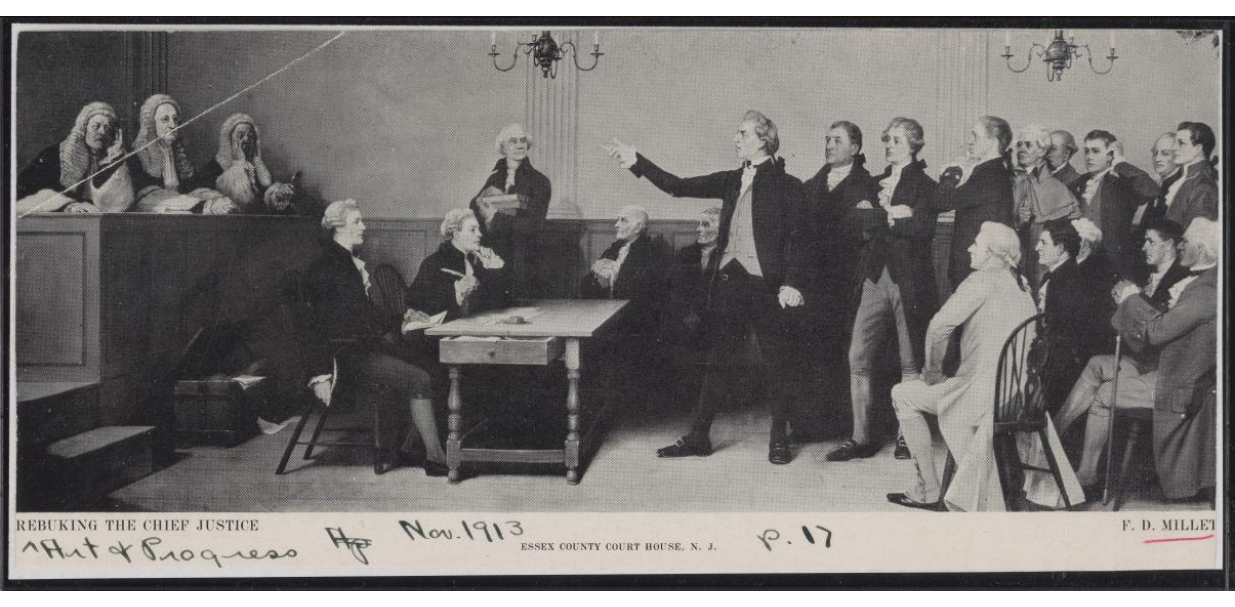
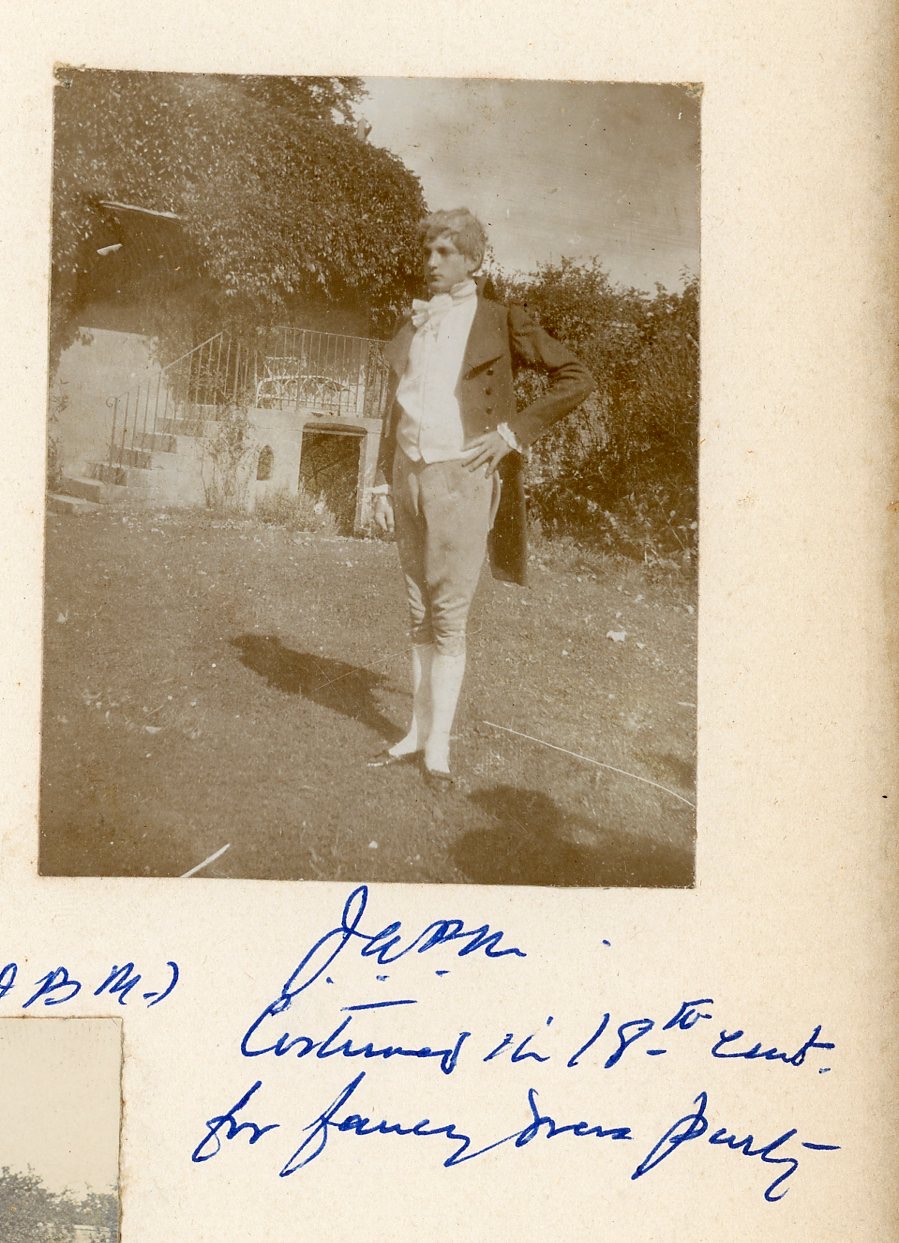
The Foreman of the Grand Jury Rebuking the Chief Justice of New Jersey, 1774
Date: 1906
Dimensions: Mural: Height: cm ( in.), Width: cm ( in.) Preparatory painting – on canvas: Height: 48.3 cm (19 in.), Width: 123.5 cm (48..62 in.)
Medium: Mural – oil on canvas Preparatory painting – on canvas
Owner/Location: Mural: Essex County Courthouse, Newark, New Jersey, USA Preparatory painting: Owned by Millet family descendants
Description
John Alfred Parsons Millet ( named after John S. Sargent & Alfred Parsons) stands in the 18th Century costume worn as the model for his fathers painting “The Foreman of the Grand Jury…” This photo [on the left] among others kept in the family photo album.
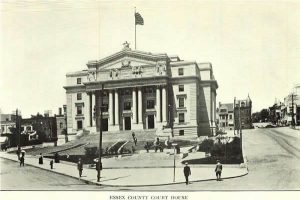
Essex County Courthouse, Newark, NJ
In Courtroom 211, which is the former Grand Jury room, is the Foreman of the Grand Jury Rebuking the Chief Justice of New Jersey in 1774 by Francis Davis Millet (1846-1912).
In this painting, the history of the scene depicted is one of the most stirring incidents connected with the history of the city and county just prior to the Revolutionary War. Chief Justice Smith, with associate justices, listen in the courtroom as the foreman of the Grand Jury delivers an impassioned address regarding the tyranny of the British over the colonies. The foreman is the central figure, with his right arm extended in a gesture of protest as he faces the judges and speaks. A portion of the foreman’s speech was kept and is reported in a 1907 Harper’s Weekly issue at the dedication of the paintings installation. “Frederick Smyth was the last – of the provincial chief justices of New Jersey. He received his commission October 17, 1764, and remained in office until the adoption of the Constitution of 1776. In his charge to the grand jury of the county of Essex, at the term of November, 1774, he alluded to the troubled state of the times, and, among other things, observed:
“…that the imaginary tyranny three thousand miles distant, was less to be feared and guarded against, than the ‘real tyranny at our own doors.” “This was bold language to be uttered at such a time, and in such a place, and it drew from the grand jury a reply so spirited and patriotic that it, deserves a conspicuous place among the memorials of our Revolutionary history. Respecting the tyranny at the distance of three thousand miles.’ Declared the foreman,’ which your Honor is pleased to represent as imaginary.’ We have the unhappiness widely to differ from you in opinion. The effect, sir, of that tyranny, is too severely felt to have altogether thought it visionary. We cannot think, sir, that taxes imposed upon us by our fellow subjects, in a legislature in which we were not represented, is imaginary, but that it is a real and actual tyranny, and of which no nation whatsoever can furnish a single instance. We cannot think, sir, that depriving us of the inestimable right of trial by jury; seizing our persons and carrying us for trial to Great Britain, is a tyranny merely imaginary. Nor can we think with your Honor that destroying charters and changing our forms of government is a tyranny altogether, ideal. . . . In a word, sir, we cannot persuade ourselves that the fleet, now blocking up the port of Boston, consisting of ships built of real English oak, and solid iron, and armed with cannon of ponderous metal; nor the army lodged in the town of Boston, and the fortifications thrown about it, substantial and formidable realities, are all creatures of the imagination. These, sir, are but a few of the numerous grievances under which America now groans. These are some of the effects of that deliberate plan of tyranny, concerted at three thousand miles distance, and which, to your Honor, appears only like the baseless fabric of a vision…”
In Courtroom 211, of the Essex County, New Jersey courthouse, which is the former Grand Jury room, is the large painting by Francis Davis Millet (1846-1912) entitled “Foreman of the Grand Jury Rebuking the Chief Justice of New Jersey in 1774.” Millet was commissioned an American painter, sculptor and writer who was also recognized at the time to be one of the country’s leading mural painters, to be in charge of all the decorations of the newly constructed courthouse. Millet contracted with a number of other painters and decorators to complete various parts of the building. However, he reserved the “Forman” painting for himself. He used his young son as the model for the foreman and placed him in the appropriate dress of the time, from Millet’s extensive costume collection. Millet maintained homes both in New York City and in Broadway, England and consequently had a deep understanding of both American and British History.
In this painting, the history of the scene depicted is one of the most stirring incidents connected with the history of the city and county just prior to the Revolutionary War. Chief Justice Smith, with associate justices, listen in the courtroom as the foreman of the Grand Jury delivers an impassioned address regarding the tyranny of the British over the colonies. The foreman is the central figure, with his right arm extended in a gesture of protest as he faces the judges and speaks.
The following pdfs give a look inside the courthouse building:
Foreman painting in Essex County NJ Courthouse
https://dana.njit.edu/items/show/526
Restoration of the building done by EverGreene Architectural Arts. Images below show the beautiful results of the Essex restoration work. EverGreene also completed the restoration of the nearby Hudson County Courthouse in Jersey City, for which Millet was commissioned as the decorator. Hudson photos can be viewed in Gallery Tab and the Hudson restoration plan can be found in the Research Tab.
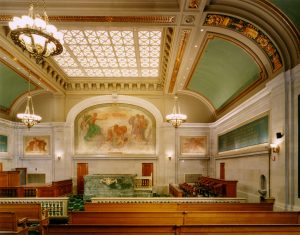
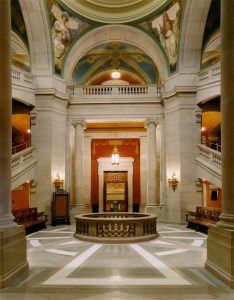
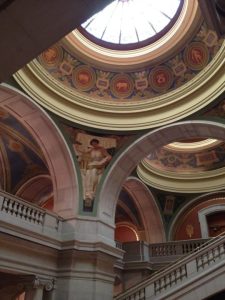
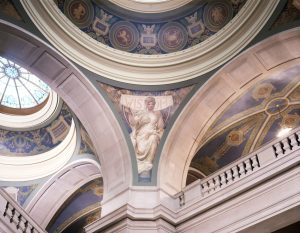
There is also a known preparatory study done for this painting of the three gentlemen standing behind the Foreman:
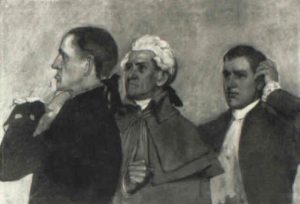
Exhibitions / Provenance
Exhibitions:
1999, FD Millet Easel Paintings, Guild of Boston Artists, Boston, MA April 1999
Provenance:
Literature
Research:
Publications:
1907, Harper’s Weekly: Volume 51, Part 2 pg. 1245. Quotes part of the Foreman’s speech to the Chief Justice; quoted in Description above.
1916, Brochure of the Mural Painters, a National Society Founded 1895, New York: the Kalkhoff Company, 1916.
1986, Heroes in the fight for beauty: the muralists of the Hudson County Court House. Jersey City: Jersey City Museum, 1986, pg. 94.
